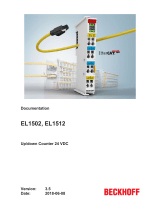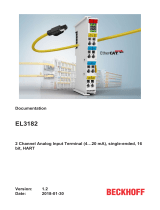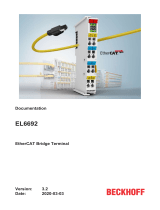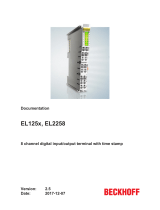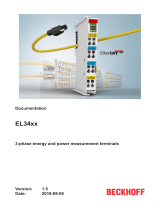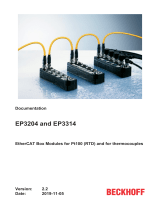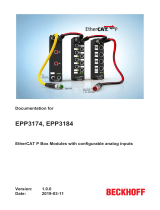Page is loading ...

Documentation
EL6752
Master/Slave Terminal for DeviceNet
2.1
2018-12-11
Version:
Date:


Table of contents
EL6752 3Version: 2.1
Table of contents
1 Foreword ....................................................................................................................................................5
1.1 Notes on the documentation..............................................................................................................5
1.2 Safety instructions .............................................................................................................................6
1.3 Documentation issue status ..............................................................................................................7
1.4 Version identification of EtherCAT devices .......................................................................................7
2 Product overview.....................................................................................................................................12
2.1 Introduction......................................................................................................................................12
2.2 Technical data .................................................................................................................................13
3 Basic DeviceNet principles.....................................................................................................................14
4 Mounting and cabling..............................................................................................................................15
4.1 Instructions for ESD protection........................................................................................................15
4.2 Recommended mounting rails.........................................................................................................15
4.3 Mounting and demounting - terminals with traction lever unlocking ................................................15
4.4 Mounting and demounting - terminals with front unlocking .............................................................17
4.5 DeviceNet wiring..............................................................................................................................19
4.5.1 CAN / DeviceNet topology ............................................................................................... 19
4.5.2 Bus length........................................................................................................................ 20
4.5.3 Drop lines......................................................................................................................... 20
4.5.4 Star Hub (Multiport Tap) .................................................................................................. 21
4.5.5 CAN cable........................................................................................................................ 22
4.5.6 Shielding .......................................................................................................................... 22
4.5.7 Cable colours and pin assignment................................................................................... 23
4.6 Installation positions ........................................................................................................................23
4.7 Positioning of passive Terminals .....................................................................................................26
4.8 ATEX - Special conditions (standard temperature range) ...............................................................27
5 DeviceNet communication......................................................................................................................28
5.1 DeviceNet Introduction ....................................................................................................................28
5.2 Explicit messages............................................................................................................................30
6 Parameterization and commissioning...................................................................................................32
6.1 CoE Interface...................................................................................................................................32
6.2 General notes for setting the watchdog...........................................................................................36
6.3 EtherCAT State Machine.................................................................................................................38
6.4 TwinCAT System Manager..............................................................................................................41
6.5 Beckhoff DeviceNet Bus Coupler ....................................................................................................51
6.6 General DeviceNet device...............................................................................................................56
6.6.1 Integrating a DeviceNet device with EDS file .................................................................. 56
6.6.2 Integrating a DeviceNet device without EDS file ............................................................. 57
6.6.3 Parameterization of a DeviceNet device.......................................................................... 60
6.7 EtherCAT description ......................................................................................................................65
6.7.1 Introduction ...................................................................................................................... 65
6.7.2 Object description and parameterization ......................................................................... 70
7 Error handling and diagnostics..............................................................................................................82
7.1 EL6752 - LED description................................................................................................................82

Table of contents
EL67524 Version: 2.1
7.2 EL6752/-0010 diagnostics ...............................................................................................................84
7.2.1 EL6752/-0010 - WC-State ............................................................................................... 84
7.2.2 EL6752/-0010 - State....................................................................................................... 85
7.2.3 EL6752/-0010 - Error / DiagFlag...................................................................................... 86
7.3 DeviceNet device diagnostics..........................................................................................................86
7.3.1 DeviceNet slave device / EL6752-0010 - MacState ........................................................ 86
7.3.2 DeviceNet slave device / EL6752-0010 - DiagFlag ......................................................... 88
7.3.3 Beckhoff DeviceNet slave device - CouplerState ........................................................... 89
7.4 EL6752/-0010 - ADS Error Codes ...................................................................................................90
7.5 DeviceNet / CAN Trouble Shooting .................................................................................................94
8 Appendix ..................................................................................................................................................97
8.1 UL notice .........................................................................................................................................97
8.2 EtherCAT AL Status Codes.............................................................................................................98
8.3 Firmware compatibility.....................................................................................................................98
8.4 Firmware Update EL/ES/EM/EPxxxx ..............................................................................................99
8.4.1 Device description ESI file/XML..................................................................................... 100
8.4.2 Firmware explanation .................................................................................................... 103
8.4.3 Updating controller firmware *.efw................................................................................. 104
8.4.4 FPGA firmware *.rbf....................................................................................................... 105
8.4.5 Simultaneous updating of several EtherCAT devices.................................................... 109
8.5 ATEX Documentation ....................................................................................................................110
8.6 Abbreviations.................................................................................................................................110
8.7 Support and Service ......................................................................................................................111

Foreword
EL6752 5Version: 2.1
1 Foreword
1.1 Notes on the documentation
Intended audience
This description is only intended for the use of trained specialists in control and automation engineering who
are familiar with the applicable national standards.
It is essential that the documentation and the following notes and explanations are followed when installing
and commissioning these components.
It is the duty of the technical personnel to use the documentation published at the respective time of each
installation and commissioning.
The responsible staff must ensure that the application or use of the products described satisfy all the
requirements for safety, including all the relevant laws, regulations, guidelines and standards.
Disclaimer
The documentation has been prepared with care. The products described are, however, constantly under
development.
We reserve the right to revise and change the documentation at any time and without prior announcement.
No claims for the modification of products that have already been supplied may be made on the basis of the
data, diagrams and descriptions in this documentation.
Trademarks
Beckhoff
®
, TwinCAT
®
, EtherCAT
®
, EtherCATP
®
, SafetyoverEtherCAT
®
, TwinSAFE
®
, XFC
®
and XTS
®
are
registered trademarks of and licensed by Beckhoff Automation GmbH.
Other designations used in this publication may be trademarks whose use by third parties for their own
purposes could violate the rights of the owners.
Patent Pending
The EtherCAT Technology is covered, including but not limited to the following patent applications and
patents: EP1590927, EP1789857, DE102004044764, DE102007017835 with corresponding applications or
registrations in various other countries.
The TwinCAT Technology is covered, including but not limited to the following patent applications and
patents: EP0851348, US6167425 with corresponding applications or registrations in various other countries.
EtherCAT
®
is registered trademark and patented technology, licensed by Beckhoff Automation GmbH,
Germany.
Copyright
© Beckhoff Automation GmbH & Co. KG, Germany.
The reproduction, distribution and utilization of this document as well as the communication of its contents to
others without express authorization are prohibited.
Offenders will be held liable for the payment of damages. All rights reserved in the event of the grant of a
patent, utility model or design.

Foreword
EL67526 Version: 2.1
1.2 Safety instructions
Safety regulations
Please note the following safety instructions and explanations!
Product-specific safety instructions can be found on following pages or in the areas mounting, wiring,
commissioning etc.
Exclusion of liability
All the components are supplied in particular hardware and software configurations appropriate for the
application. Modifications to hardware or software configurations other than those described in the
documentation are not permitted, and nullify the liability of Beckhoff Automation GmbH & Co. KG.
Personnel qualification
This description is only intended for trained specialists in control, automation and drive engineering who are
familiar with the applicable national standards.
Description of instructions
In this documentation the following instructions are used.
These instructions must be read carefully and followed without fail!
DANGER
Serious risk of injury!
Failure to follow this safety instruction directly endangers the life and health of persons.
WARNING
Risk of injury!
Failure to follow this safety instruction endangers the life and health of persons.
CAUTION
Personal injuries!
Failure to follow this safety instruction can lead to injuries to persons.
NOTE
Damage to environment/equipment or data loss
Failure to follow this instruction can lead to environmental damage, equipment damage or data loss.
Tip or pointer
This symbol indicates information that contributes to better understanding.

Foreword
EL6752 7Version: 2.1
1.3 Documentation issue status
Version Comment
2.1 • Chapter “Explicit messages” added
• Update chapter “Technical data”
• Update structure
• Update revision status
2.0 • Migration
• Update structure
1.4 • Addendum: chapter "Configuration": changing DeviceNet address and baud
rate via ADS
• Update structure
1.3 • Correction to chapter "Technical data"
• Addendum:chapter "Firmware status"
• Update structure
1.2 • Corrections to chapter "Mounting and wiring"
1.1 • Corrections to chapter "Mounting and wiring"
1.0 • Corrections and addenda, first publication
0.2 • Corrections and addenda
0.1 • Preliminary version for internal use
1.4 Version identification of EtherCAT devices
Designation
A Beckhoff EtherCAT device has a 14-digit designation, made up of
• family key
• type
• version
• revision
Example Family Type Version Revision
EL3314-0000-0016 EL terminal
(12 mm, non-
pluggable connection
level)
3314 (4-channel thermocouple
terminal)
0000 (basic type) 0016
ES3602-0010-0017 ES terminal
(12 mm, pluggable
connection level)
3602 (2-channel voltage
measurement)
0010 (high-
precision version)
0017
CU2008-0000-0000 CU device 2008 (8-port fast ethernet switch) 0000 (basic type) 0000
Notes
• The elements mentioned above result in the technical designation. EL3314-0000-0016 is used in the
example below.
• EL3314-0000 is the order identifier, in the case of “-0000” usually abbreviated to EL3314. “-0016” is the
EtherCAT revision.
• The order identifier is made up of
- family key (EL, EP, CU, ES, KL, CX, etc.)
- type (3314)
- version (-0000)

Foreword
EL67528 Version: 2.1
• The revision -0016 shows the technical progress, such as the extension of features with regard to the
EtherCAT communication, and is managed by Beckhoff.
In principle, a device with a higher revision can replace a device with a lower revision, unless specified
otherwise, e.g. in the documentation.
Associated and synonymous with each revision there is usually a description (ESI, EtherCAT Slave
Information) in the form of an XML file, which is available for download from the Beckhoff web site.
From 2014/01 the revision is shown on the outside of the IP20 terminals, see Fig. “EL5021 EL terminal,
standard IP20 IO device with batch number and revision ID (since 2014/01)”.
• The type, version and revision are read as decimal numbers, even if they are technically saved in
hexadecimal.
Identification number
Beckhoff EtherCAT devices from the different lines have different kinds of identification numbers:
Production lot/batch number/serial number/date code/D number
The serial number for Beckhoff IO devices is usually the 8-digit number printed on the device or on a sticker.
The serial number indicates the configuration in delivery state and therefore refers to a whole production
batch, without distinguishing the individual modules of a batch.
Structure of the serial number: KKYYFFHH
KK - week of production (CW, calendar week)
YY - year of production
FF - firmware version
HH - hardware version
Example with
Ser. no.: 12063A02: 12 - production week 12 06 - production year 2006 3A - firmware version 3A 02 -
hardware version 02
Exceptions can occur in the IP67 area, where the following syntax can be used (see respective device
documentation):
Syntax: D ww yy x y z u
D - prefix designation
ww - calendar week
yy - year
x - firmware version of the bus PCB
y - hardware version of the bus PCB
z - firmware version of the I/O PCB
u - hardware version of the I/O PCB
Example: D.22081501 calendar week 22 of the year 2008 firmware version of bus PCB: 1 hardware version
of bus PCB: 5 firmware version of I/O PCB: 0 (no firmware necessary for this PCB) hardware version of I/O
PCB: 1
Unique serial number/ID, ID number
In addition, in some series each individual module has its own unique serial number.
See also the further documentation in the area
• IP67: EtherCAT Box
• Safety: TwinSafe
• Terminals with factory calibration certificate and other measuring terminals

Foreword
EL6752 9Version: 2.1
Examples of markings
Fig.1: EL5021 EL terminal, standard IP20 IO device with serial/ batch number and revision ID (since
2014/01)
Fig.2: EK1100 EtherCAT coupler, standard IP20 IO device with serial/ batch number
Fig.3: CU2016 switch with serial/ batch number

Foreword
EL675210 Version: 2.1
Fig.4: EL3202-0020 with serial/ batch number 26131006 and unique ID-number 204418
Fig.5: EP1258-00001 IP67 EtherCAT Box with batch number/ date code 22090101 and unique serial
number 158102
Fig.6: EP1908-0002 IP67 EtherCAT Safety Box with batch number/ date code 071201FF and unique serial
number 00346070
Fig.7: EL2904 IP20 safety terminal with batch number/ date code 50110302 and unique serial number
00331701

Foreword
EL6752 11Version: 2.1
Fig.8: ELM3604-0002 terminal with unique ID number (QR code) 100001051 and serial/ batch number
44160201

Product overview
EL675212 Version: 2.1
2 Product overview
2.1 Introduction
Fig.9: EL6752
Master and slave terminals for DeviceNet
The master and slave terminals for DeviceNet correspond to the FC5201 PCI card from Beckhoff. Thanks to
the connection via EtherCAT, no PCI slots are required in the PC. Within an EtherCAT terminal network, the
terminal enables the integration of any DeviceNet devices.
The EL6752 is optionally available in a master or slave version and has a powerful protocol implementation
with many features:
• All I/O modes of the DeviceNet are supported: polling, change of state, cyclic, strobed
• Unconnected message manager (UCMM)
• Powerful parameter and diagnostics interfaces
• Error management freely configurable for each bus device
A description of all functionalities and operating modes can be found in the chapter "Configuration [}65]"
and the corresponding subsections.

Product overview
EL6752 13Version: 2.1
2.2 Technical data
Technical data EL6752-0000 EL6752-0010
Bus system DeviceNet
Variante Master Slave
Number of fieldbus channels 1
Data transfer rate 125, 250 or 500 kbaud
Bus interface Open style 5-pin connector according to DeviceNet specification,
galvanically isolated; card comes with connector.
Bus devices maximum 63 slaves
Communication DeviceNet network master
(scanner)
DeviceNet - slave
Diagnostics Status LEDs
Power supply via the E-bus
Current consumption via E-bus typ. 260 mA
Electrical isolation 500 V (E-bus/CANopen)
Configuration with TwinCAT System Manager
Weight approx. 70 g
Permissible ambient temperature range
during operation
-25°C ... +60°C (extended temperature range)
0°C ... +55°C (according to cULus [}97] for Canada and the
USA)
0°C ... +55°C (according to ATEX [}27], see special conditions
[}27])
Permissible ambient temperature range
during storage
-40°C ... +85°C
Permissible relative humidity 95%, no condensation
Dimensions (W x H x D) approx. 26 mm x 100 mm x 52 mm
Mounting [}15]
on 35 mm mounting rail conforms to EN 60715
Vibration/shock resistance conforms to EN 60068-2-6 / EN 60068-2-27
EMC immunity/emission conforms to EN 61000-6-2 / EN 61000-6-4
Protection class IP20
Installation position variable
Approval CE
ATEX [}27]
cULus [}97]

Basic DeviceNet principles
EL675214 Version: 2.1
3 Basic DeviceNet principles
Introduction to the system
DeviceNet is an open system based on CAN. CAN was developed some years ago by R. Bosch for data
transmission in motor vehicles. Millions of CAN chips are now in use. A disadvantage for application in
automation is that CAN does not contain definitions for the application layer. CAN only defines the physical
and data link layer.
DeviceNet specifies a uniform application layer and this makes it possible to use the CAN protocol for
industrial applications. ODVA (the Open DeviceNet Vendor Association) is an independent association which
supports manufacturers and users of the DeviceNet system. ODVA ensures that all devices which conform
to the specification can operate together in one system, regardless of their manufacturer. CAN’s bit
arbitration procedure makes it theoretically possible to operate communication networks using master/slave
and multimaster access methods.
Further details can be found on the official website of the ODVA (http://www.odva.org).
Fig.10: Example of DeviceNet in use
Bus cable
The bus cable consists of two pairs of shielded twisted-pair wiring, one for the data transfer and one for the
power supply. The latter can carry currents of up to 8 amperes. The maximum possible length of a line
depends essentially on the baud rate. If you choose the highest Baud rate (500 kbaud) you are restricted to
lines of at most 100 m. With the lowest Baud rate (125 kbaud) you will be able to use cable with an overall
length of 500 m. Refer to the chapter "Mounting and wiring [}19]" for details
Fig.11: Example of DeviceNet cabling

Mounting and cabling
EL6752 15Version: 2.1
4 Mounting and cabling
4.1 Instructions for ESD protection
NOTE
Destruction of the devices by electrostatic discharge possible!
The devices contain components at risk from electrostatic discharge caused by improper handling.
• Please ensure you are electrostatically discharged and avoid touching the contacts of the device directly.
• Avoid contact with highly insulating materials (synthetic fibers, plastic film etc.).
• Surroundings (working place, packaging and personnel) should by grounded probably, when handling
with the devices.
• Each assembly must be terminated at the right hand end with an EL9011 or EL9012 bus end cap, to en-
sure the protection class and ESD protection.
Fig.12: Spring contacts of the Beckhoff I/O components
4.2 Recommended mounting rails
Terminal Modules und EtherCAT Modules of KMxxxx and EMxxxx series, same as the terminals of the
EL66xx and EL67xx series can be snapped onto the following recommended mounting rails:
• DIN Rail TH35-7.5 with 1mm material thickness (according to EN60715)
• DIN Rail TH35-15 with 1,5mm material thickness
Pay attention to the material thickness of the DIN Rail
Terminal Modules und EtherCAT Modules of KMxxxx and EMxxxx series, same as the terminals of
the EL66xx and EL67xx seriesdoes not fit to the DIN Rail TH35-15 with 2,2 to 2,5mm material
thickness (according to EN60715)!
4.3 Mounting and demounting - terminals with traction
lever unlocking
The terminal modules are fastened to the assembly surface with the aid of a 35 mm mounting rail (e.g.
mounting rail TH 35-15).

Mounting and cabling
EL675216 Version: 2.1
Fixing of mounting rails
The locking mechanism of the terminals and couplers extends to the profile of the mounting rail. At
the installation, the locking mechanism of the components must not come into conflict with the fixing
bolts of the mounting rail. To mount the recommended mounting rails under the terminals and cou-
plers, you should use flat mounting connections (e.g. countersunk screws or blind rivets).
WARNING
Risk of electric shock and damage of device!
Bring the bus terminal system into a safe, powered down state before starting installation, disassembly or
wiring of the Bus Terminals!
Mounting
• Fit the mounting rail to the planned assembly location.
and press (1) the terminal module against the mounting rail until it latches in place on the mounting
rail (2).
• Attach the cables.
Demounting
• Remove all the cables. Thanks to the KM/EM connector, it is not necessary to remove all the cables
separately for this, but for each KM/EM connector simply undo 2 screws so that you can pull them off
(fixed wiring)!
• Lever the unlatching hook on the left-hand side of the terminal module upwards with a screwdriver (3).
As you do this
◦ an internal mechanism pulls the two latching lugs (3a) from the top hat rail back into the terminal
module,
◦ the unlatching hook moves forwards (3b) and engages

Mounting and cabling
EL6752 17Version: 2.1
• In the case 32 and 64 channel terminal modules (KMxxx4 and KMxxx8 or EMxxx4 and EMxxx8) you
now lever the second unlatching hook on the right-hand side of the terminal module upwards in the
same way.
• Pull (4) the terminal module away from the mounting surface.
4.4 Mounting and demounting - terminals with front
unlocking
The terminal modules are fastened to the assembly surface with the aid of a 35 mm mounting rail (e.g.
mounting rail TH 35-15).

Mounting and cabling
EL675218 Version: 2.1
Fixing of mounting rails
The locking mechanism of the terminals and couplers extends to the profile of the mounting rail. At
the installation, the locking mechanism of the components must not come into conflict with the fixing
bolts of the mounting rail. To mount the recommended mounting rails under the terminals and cou-
plers, you should use flat mounting connections (e.g. countersunk screws or blind rivets).
WARNING
Risk of electric shock and damage of device!
Bring the bus terminal system into a safe, powered down state before starting installation, disassembly or
wiring of the Bus Terminals!
Mounting
• Fit the mounting rail to the planned assembly location.
and press (1) the terminal module against the mounting rail until it latches in place on the mounting
rail (2).
• Attach the cables.
Demounting
• Remove all the cables.
• Lever the unlatching hook back with thumb and forefinger (3). An internal mechanism pulls the two
latching lugs (3a) from the top hat rail back into the terminal module.

Mounting and cabling
EL6752 19Version: 2.1
• Pull (4) the terminal module away from the mounting surface.
Avoid canting of the module; you should stabilize the module with the other hand, if required.
4.5 DeviceNet wiring
4.5.1 CAN / DeviceNet topology
CAN/DeviceNet is a 2-wire bus system, to which all participating devices are connected in parallel (i.e. using
short drop lines) (Fig. DeviceNet Topology). The bus must be terminated at each end with a 120 (or 121)
Ohm terminating resistor to prevent reflections. This is also necessary even if the cable lengths are very
short!
Fig.13: DeviceNet topology
Since the CAN signals are represented on the bus as the difference between the two levels, the CAN leads
are not very sensitive to incoming interference (EMI): Both leads are affected, so the interference has very
little effect on the difference.

Mounting and cabling
EL675220 Version: 2.1
Fig.14: Low interference through difference levels
4.5.2 Bus length
The maximum length of a CAN bus is primarily limited by the signal propagation delay. The multi-master bus
access procedure (arbitration) requires signals to reach all the nodes at effectively the same time (before the
sampling within a bit period). Since the signal propagation delays in the CAN connecting equipment
(transceivers, opto-couplers, CAN controllers) are almost constant, the line length must be chosen in
accordance with the baud rate:
Baud rate Bus length
500 kbit/s < 100m
250 kbit/s < 250m
125 kbit/s < 500m
4.5.3 Drop lines
Drop lines must always be avoided as far as possible, since they inevitably cause reflections. The reflections
caused by drop lines are not however usually critical, provided they have decayed fully before the sampling
time. In the case of the bit timing settings selected in the Bus Couplers it can be assumed that this is the
case, provided the following drop line lengths are not exceeded:
Baud rate Drop line length Total length of all drop lines
500 kbit/s < 6m < 39m
250 kbit/s < 6m < 78m
125 kbit/s < 6 m < 156m
Drop lines must not be furnished with termination resistors (Fig. Drop line topology).
Fig.15: Drop line topology
/
